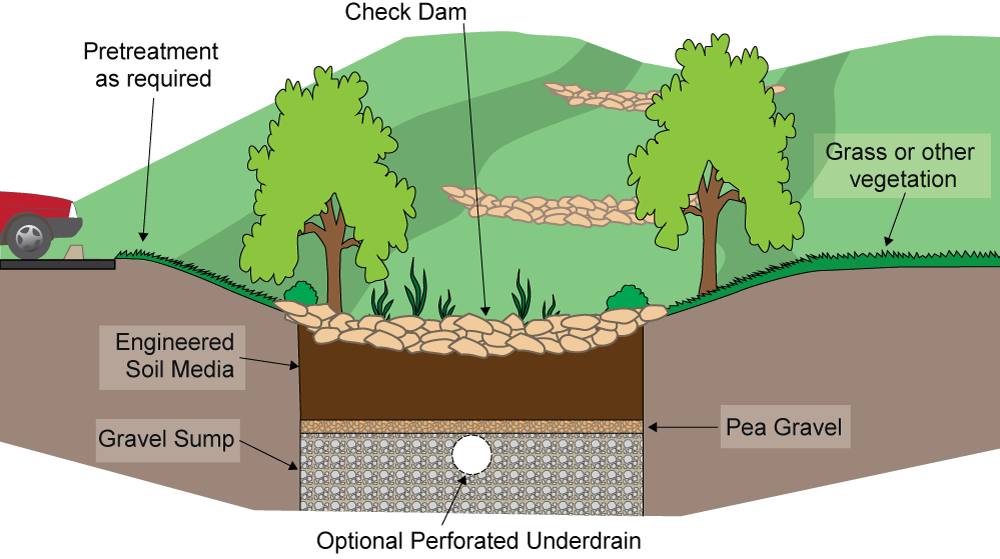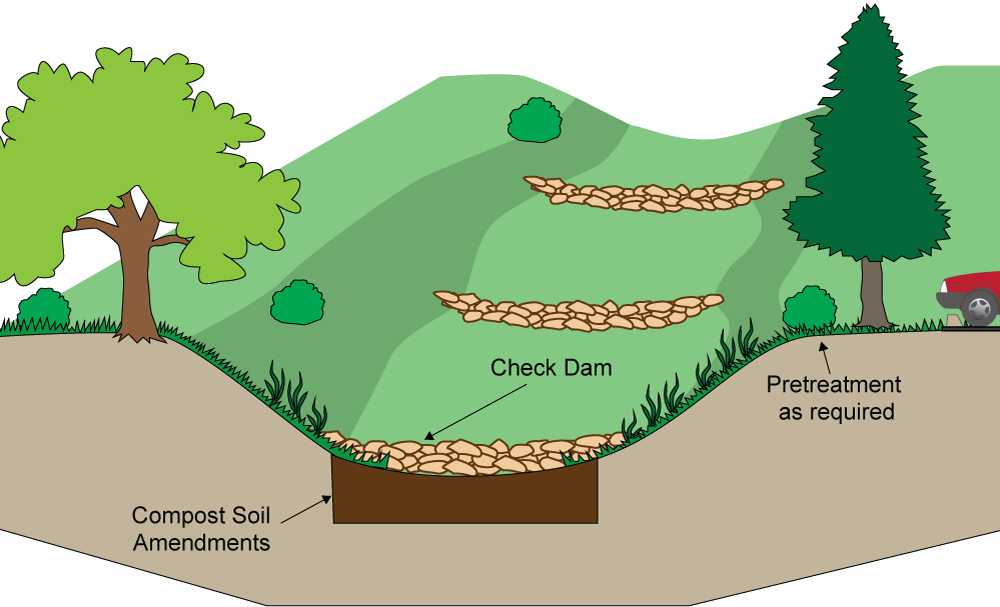
Protecting our environment, one stormwater practice at a time.
Vegetated Swales
Overview
Vegetated swales are open, gently sloping channels that are designed to convey and treat stormwater runoff. There are two types of vegetated swales: dry swales and grass channels. They perform the same hydraulic function as a traditional curb or ditch but with the added benefit of water quality treatment. Dry swales, which may also include grass swales, are similar to linear bioretention facilities. They provide water quality and quantity treatment through filtration (or infiltration), settling and plant uptake. Grass channels are typically designed as conveyance systems and provide a modest amount of water quality and quantity treatment. The main features of dry swales are engineered soil media, turf cover or plantings, check dams and an underdrain. Grass channels feature turf cover, compost soil amendments and a check dam but do not include engineered soil media or an underdrain.
How Vegetated Swales Work

Above: dry swale with underdrain.
Dry swales use plants to slow excess runoff and allow sediment to settle on the channel bottom. In addition, engineered soil media filter out other pollutants. Small check dams or weirs can be added to further slow the runoff and reduce the potential of downstream erosion. Vegetation improves stormwater quality through biological uptake; plants will absorb nutrients in the runoff for nourishment and growth. Plants are selected with deep root systems and a tolerance for fluctuations in soil moisture. Runoff percolates through the engineered soil media and either infiltrates or enters the underdrain. The underdrain is a perforated PVC pipe that lies in a bed of gravel beneath the engineered soil media. It is either connected to the stormwater drainage system or daylights further down the swale.

Above: grass channel before and after.

Above: grass channel with amendments.
How to Maintain Vegetated Swales
Dry Swales
- Weeding is required when invasive species make up more than ten percent of the vegetation
- Replant in spring and fall to maintain a plant composition that is consistent with the design
- Prune in early spring
- Inspect overflow pipe for damage and functionality twice a year
- Remove organic litter and debris as needed
- Remove any accumulated sand or sediment deposits behind check dams as needed
Grass Channels
- Mow grass to keep at a height of six inches
- Remove grass clippings after mowing
- Maintain 95 percent turf cover and reseed as necessary
- Remove organic litter and debris as needed
- Remove any accumulated sand or sediment deposits behind check dams as needed
Vegetated Swales Suggested Maintenance Timeline
Inspect overflow pipe: April and October
Pruning: March
Replanting: April and October
Remove organic litter and debris: As needed, all year long
Weeding: As needed, all year long
Reseeding: As needed, all year long
Mowing: As needed, all year long
Remove sediment behind check dams: As needed, all year long
FairFacts
- Vegetated swales may be adapted for use in most land development projects. However they should not be constructed on steep slopes or areas with very limited space.
- Dry swales may be planted with a mix of turf grass, tall meadow grass, herbaceous cover and trees. Dry swales located along roads should be planted with salt-tolerant species. Beautyberry, Red Osier Dogwood, Sweetgum and Sweetbay Magnolia are all tolerant to road salt.
- Grass channels should be planted with native, broadleaf species of grass that have a deep root system to resist scouring and that are water-tolerant. Bottlebrush Grass, Virginia Wild Rye, Little Bluestem and Switchgrass are all grass species native to Virginia.
- Engineered soil media replaces native soils with a prepared media that provides adequate drainage, supports plant growth and facilitates pollutant removal.
The information in this fact sheet is general in nature and is not intended to determine maintenance responsibility.
For more information, contact:
Department of Public Works and Environmental Services, Maintenance and Stormwater Management Division
10635 West Drive, Fairfax, VA 22030
703-877-2800, TTY 711
ContactMSMD@fairfaxcounty.gov

